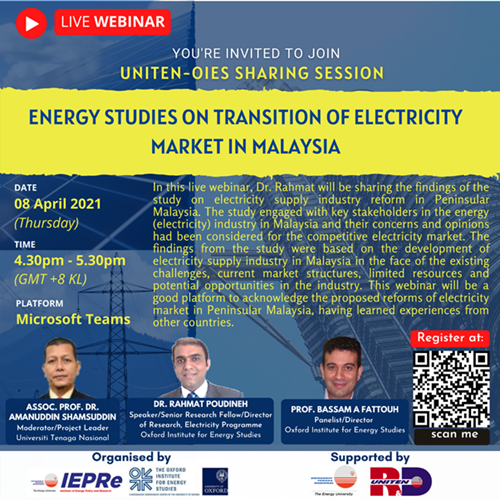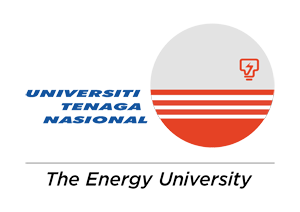Energy Studies on Transition of Electricity Market In Malaysia
Published on Monday, March 29, 2021Dr. Rahmat Poudineh presented the electricity supply industry reform and design of a competitive electricity market in Malaysia. He started by highlighting the objective of the Malaysian energy sector which he said can be captured by the Energy trilemma. He explained that the energy trilemma includes energy security, environmental sustainability, and energy equity. He said the Malaysian government has been involved in resource and energy diversification to reduce the HHI index. As a result that targets have been set to boost the amount of RE in the energy mix. In terms of environmental sustainability, the objective is to reduce greenhouse emissions by 45% in 2030. He said the green technology master plan has been introduced to increase the use of green technology in carbon-intensive sectors. Also, there is a high focus on energy efficiency and the deployment of electric vehicles. In terms of Energy equity, the objective is to ensure cost-effective energy generation. Programs such as optimal generation expansion plan and fuel portfolio diversification have been introduced. He went further to analyze the evolution of the Malaysian Electricity Supply Industry (MESI) which he said began in 1990 with the intention of electrification of the nation.
The various achievement includes the completion of the national grid to supply electricity to Peninsular Malaysia, the increase in electrification to 94%, and the electricity supply by the national electricity board (NEB). Furthermore, between 1960 and 2000, there was the privatization of the electricity industry. This was facilitated by the electricity supply act in 1990, the privatization of TNB in 1990, and the subsequent enlisting in Kuala Lumpur Stock Exchange.
The commencement of the first-generation independent power producer. Between 2001 and 2013, there was an objective to instill good governance in the electricity sector. This was facilitated by the establishment of the energy commission in 2001 end the approval of MESI reform 1.0 in late 2009. Between 2014 and 2018, the focus was on increasing efficiency and sustainability. This includes the launch of the incentive-based regulation (IBR) framework in 2014 and the IR program refresh. in 2048, Dr. Rahmat went further to explain Malaysian Electricity Supply Industry (MESI) 1.0 which he stated has some shortcomings. He stated that MESI 1.0 was challenged with a lack of incentive to procure lower cost of fuel for electricity generation due to pass-through nature; hence no price risk to IPP. It also has a higher based tariff due to surplus capacity.
The PPAS framework is outdated as well as the lack of renewable energy. Also, incentive-based regulation resulted in no incentive for efficiency in CAPEX spending. Ownership of single buyer and system operator by TNB makes it bias to TNB compared to other players. The consumer has no options in selecting provider and service package. Commercial and industrial tariffs are not as competitive as Singapore and Vietnam. And pricing mechanism is non-cost reflective resulting in probable inefficient use. He also highlighted the energy market design in terms of generation market design and Retail electricity market. On a final note, he highlighted the design of renewable support schemes for the Malaysian electricity sector to include; Indirect support policies for renewables; Direct support policies for renewables; Production based schemes; investment-based schemes; Revenue sufficiency of renewable support schemes; Burden sharing of renewable support schemes; The trade-off between market compatibility and investors' incentive; Balancing responsibility and priority dispatch.

The slide for this webinar can be downloaded here

